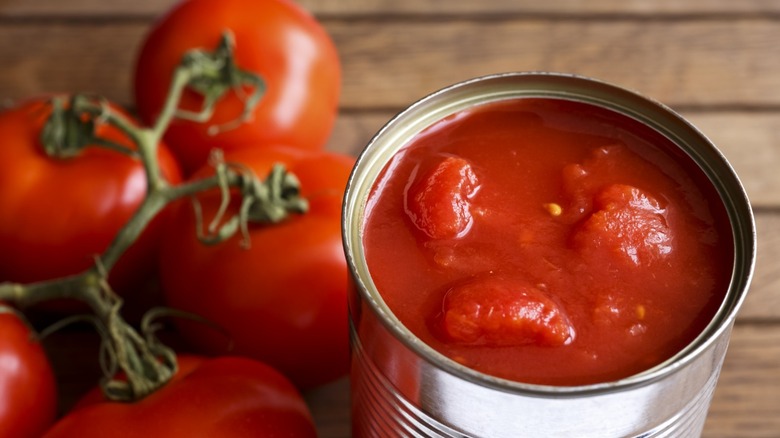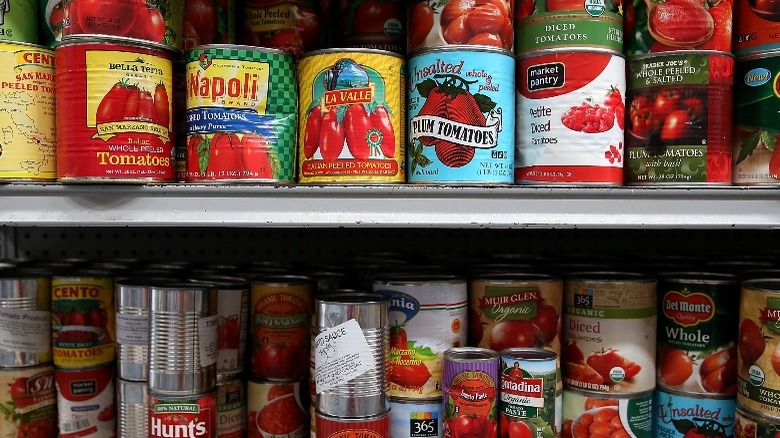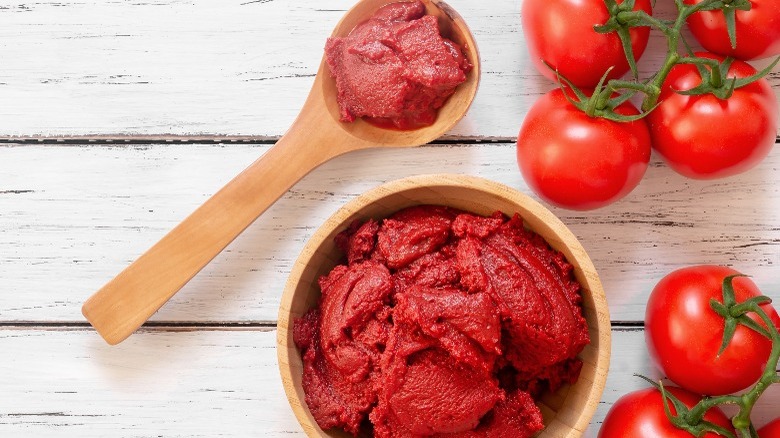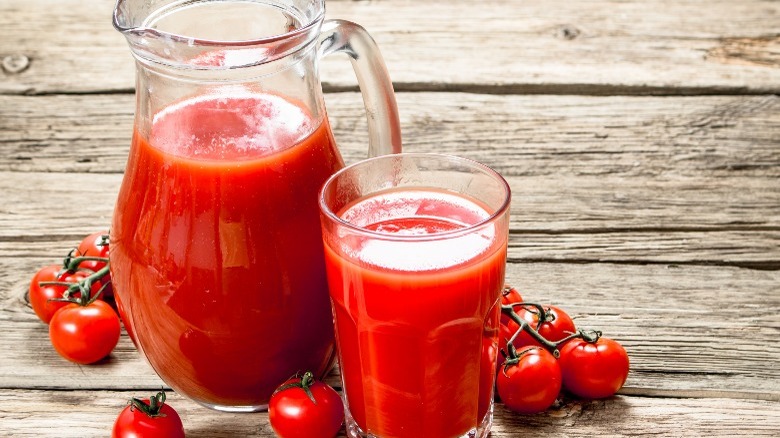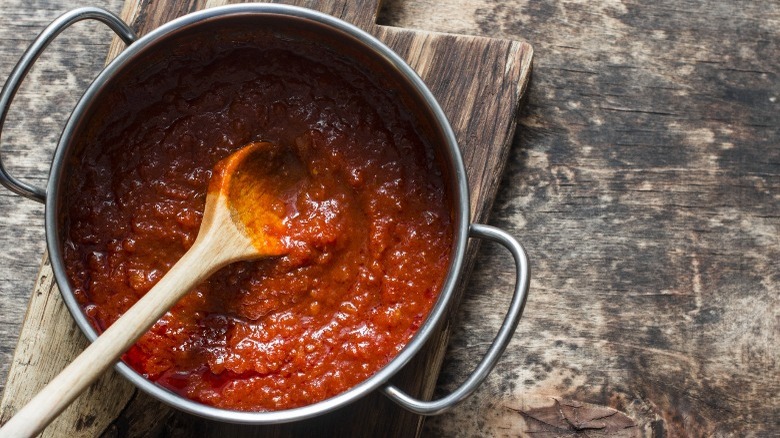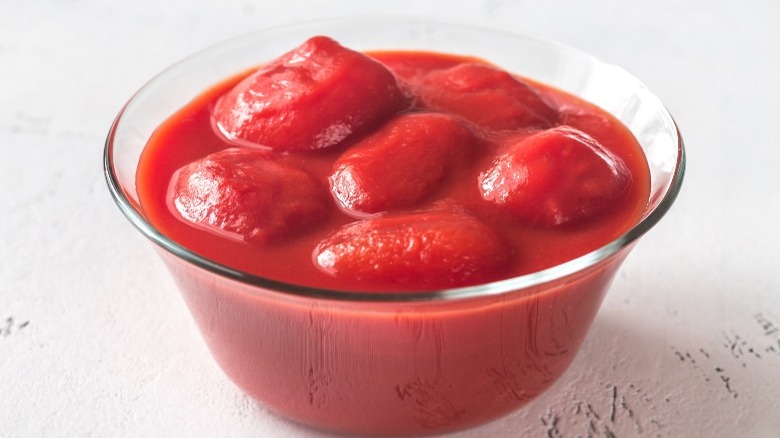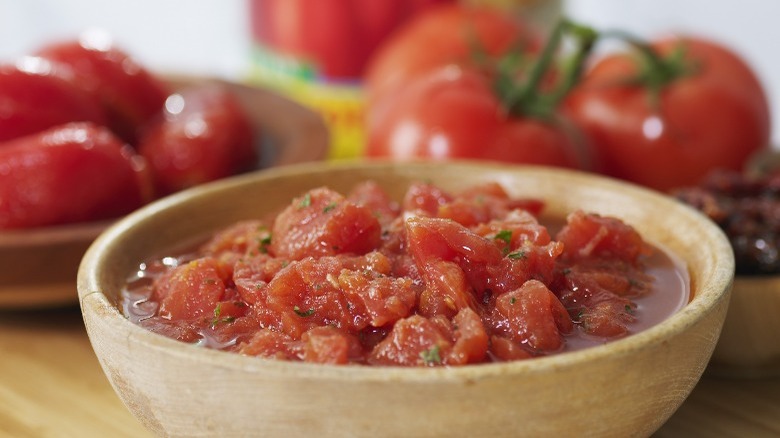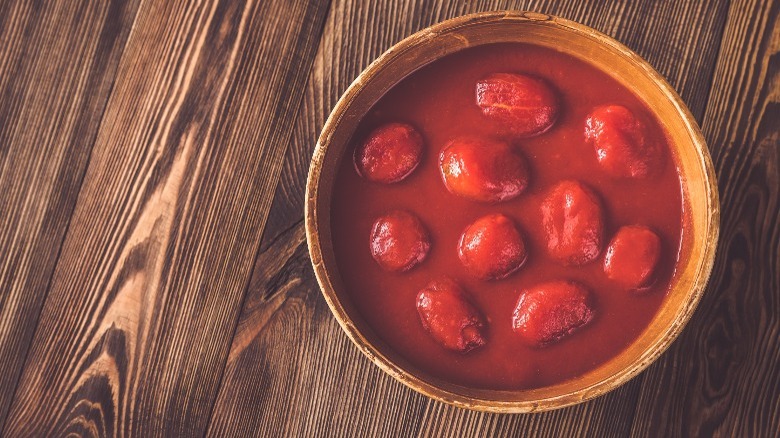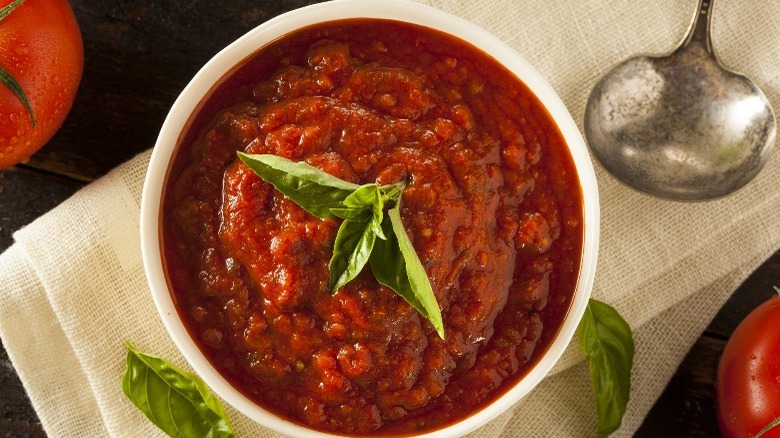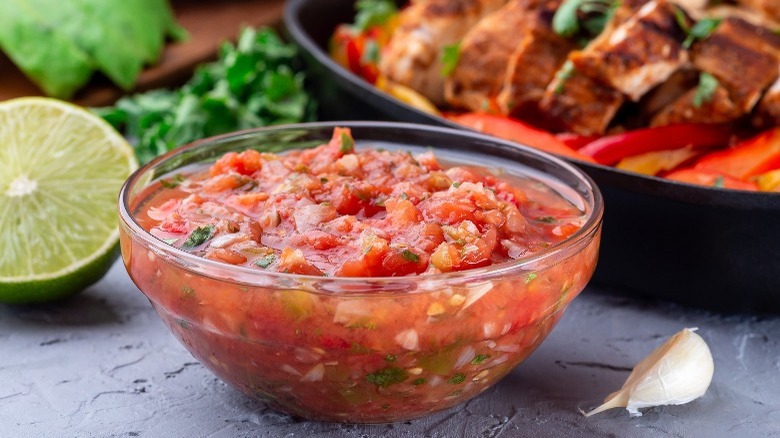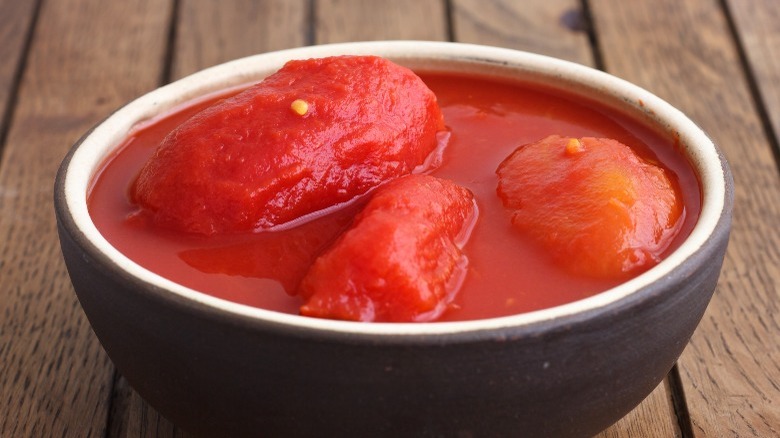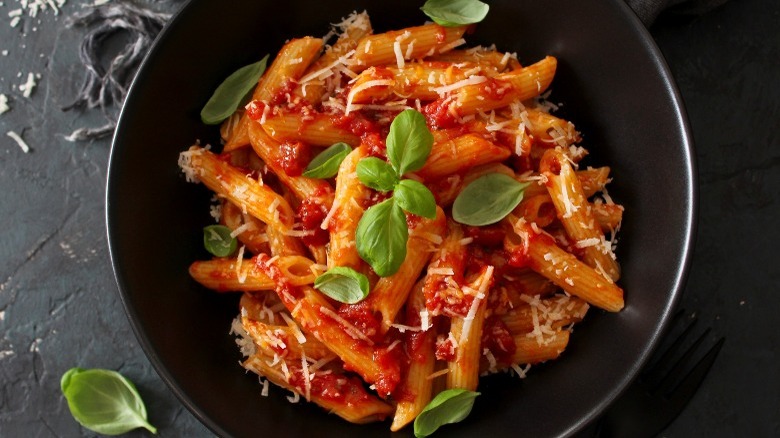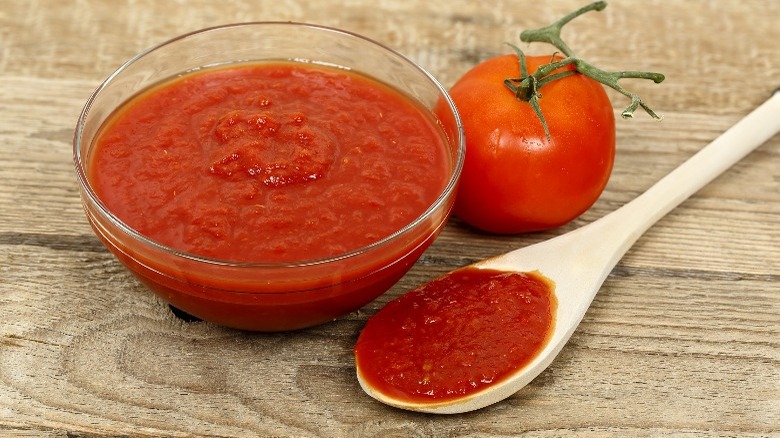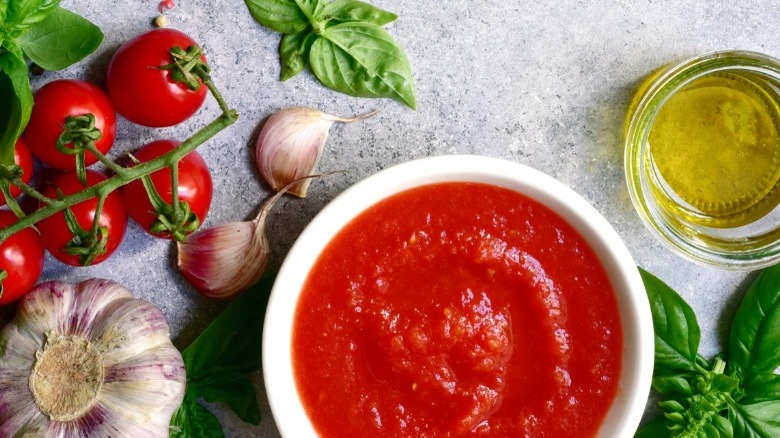15 Tips You Need When Cooking With Canned Tomatoes
In the heart of one's home, there is always some form of a pantry stuffed with nonperishable staples like pasta, rice, canned seafood, and much more. Canned tomatoes stand out amongst the rest for more reasons than we can count.
With the help of canned whole tomatoes, pizza and pasta sauces come together in just minutes. On grilled cheese sandwich night, you'll love whipping up a scratch tomato soup, and yes, the flavor is always superior to the premade version. Plus, depending on what you're making, canned tomatoes can be used instead of fresh ones; often, it's better for flavor and texture.
Before you start going down that fabled road of myths about canned food, we're here to tell you most of them have been debunked by now. Preservation methods like canning help maintain and, in the case of tomatoes, encourage the further release of certain nutrients (per Healthline). So don't think twice about stocking up on those tin cans; go ahead and grab your favorites.
From understanding how to use all the different types to learning how to season and balance acidity, there are plenty of important tips to be learned when cooking with canned tomatoes.
Know the difference in each type of canned tomato
Perusing the canned tomato aisle can be intimidating if it's not often a place you find yourself standing. With variations of pureed, crushed, and stewed, not to mention oddballs like fire-roasted and varieties with additional ingredients like green chiles and garlic, how can you know which type of canned tomatoes works best for a recipe you want to make?
Whole-peeled tomatoes are the least processed and boast superior quality, especially when you purchase the San Marzano variety. If you don't mind chopping or puréeing, always have a few large cans at home. Otherwise, diced and petite-diced tomatoes are all about convenience; throw them in a chili, soup, or stew without slicing a thing.
Fire-roasted tomatoes offer a fabulous smoky-char flavor, and tomatoes with green chiles are just what you need for Southwestern-style foods that require an additional oomph of flavor. Tomato paste is a thick, cooked-down version that helps bring tremendous tomato flavor to dishes without using a lot. Crushed, puréed, and tomato sauce all serve different purposes and come in varying textures and consistencies, so having a few cans on hand will always come in handy.
Always have canned paste and tube paste on hand
Tomato paste is made by cooking tomatoes until the batch reaches a thick, paste-like consistency. Of all canned tomato varieties, it is one you always want on hand, as a little bit goes a long way. Tomato paste is excellent for adding a punch of intensified tomatoey flavor. A smidge will amp up the flavor in meatloaf, chili, and even bland pasta sauces that need something special. You'll also love swirling a dab of paste into hearty stews and soups.
Here's the issue with tomato paste — most cans come in a small 6-ounce size, which is still too much for most recipes, despite its small size. That's why we firmly believe in having both the canned and tube versions in stock. Store the squeezable tube version in your fridge to add small amounts to recipes without wasting leftovers. Keep cans for larger recipes that call for more than a few tablespoons at a time.
If you ever find yourself with leftover canned tomato paste, you'll have to try Martha Stewart's genius tomato paste hack that involves freezing it for future months.
Skip canned tomato soup and make your own
Nothing will ever beat the nostalgia of certain childhood foods. You cannot make your own version of Kraft Macaroni & Cheese, and don't even bother replacing Pillsbury Toaster Strudel with a fancy homemade version. The idea sounds nice, but the sentimental memories that come with some of those old-school foods are irreplaceable.
With all that said, we wouldn't want you to recreate your favorite canned tomato soup dinner if it means pushing your reminiscences aside. However, if there is one childhood treat we recommend occasionally upgrading, it is tomato soup, but only for flavor purposes. All you have to do is prep already canned tomatoes.
A little bit of roasting and caramelizing canned tomatoes with a pinch of brown sugar, and you are on your way to one heck of a dreamy dinner. You might already know about balancing acidity with sugar, but the combination of high-heat roasting with brown sugar lends more to this hot bowl.
Roasting whole-tinned tomatoes with a pinch of brown sugar will enhance the sweet essence of tomatoes, while also removing moisture. It'll lend to a rich consistency you're taste buds (and belly) will love.
Always save the drained juices
Sometimes a recipe calls for a drained can of tomatoes. Instinctively, that leads us to the sink, where we pour those tomato juices right down the drain. Next time you find yourself in this situation, stop before heading to the sink and save that flavorful juice instead. Take the flavor up a notch by using up that red liquid gold.
Rather than ditching, store those extra tomato juice preserves in a food container and set them inside your fridge. As long as you use them within a week, tomato juices go well in several dishes. If you have sauces, soups, or stews on the menu within the same week, you'll appreciate having those precious flavorful juices on hand.
If you don't think you will use them in time, grab an ice cube tray, get to pouring, and freeze them overnight, then store them in a Ziploc baggie. If you need help cooling down a soup or stew, or your recipe needs additional flavor, you'll have cubes ready. If you love a good Bloody Mary every now and then, you'll also enjoy using tomato juice cubes to keep your cocktail cold without ever diluting it.
Canned is better for soups, stews, and sauces
You've heard it before: "Fresh is always better." Sure, that makes sense for raw applications filled with other fresh ingredients. We won't argue that sliced tomatoes taste amazing over a bed of greens with scratch vinaigrette. Cold sandwiches and in-season starters loaded with bursts of fresh tomatoes make for a great treat, too.
But, when it comes to cooking hot meals, canned tomatoes are almost always superior to their fresh counterparts. According to Daily Meal, canned tomatoes boast a much higher flavor concentration and withstand heat better than fresh ones. So, don't bother blanching and peeling tomatoes. The canned ones are more flavorful and convenient to throw in the pot.
Recipes that call for long simmering times, like soups, stews, and sauces, will always taste better when canned tomatoes are used. Whether you have plans to make a hearty Bolognese for guests or a giant pot of chili for the family, you'll appreciate grabbing a can or two of tomatoes instead of fresh ones.
Combine fresh and canned tomatoes for raw applications
Fresh Roma tomatoes are fabulous, especially at the peak of the harvest season. Whether you're an avid gardener or a home chef at heart, you know that the hype of the growing season is short-lived. Luckily, canned tomatoes sometimes have a way of saving the day, even in raw applications.
While nothing beats the quality of fresh tomatoes that are in season, some suggest that canned tomatoes are better than out-of-season tomatoes in foods like bruschetta. The easiest way to elevate canned tomatoes for this savory starter is by roasting seeded whole tomatoes (from the can), then chopping them up and combining them with fresh basil and minced garlic. Slab some over some toasty bread and enjoy.
You'll also appreciate this hack if you only have one tomato to spare and need a little more for your favorite garlicky appetizer. Dice up your fresh tomato and combine it in the bowl of freshly roasted tomato as it cools down. This will help soften your fresh diced tomato, so the contrast of both isn't so pronounced.
Canned whole tomatoes are best for sauces
By now, you have likely caught on that canned whole tomatoes are our favorite type, as they offer an abundance of benefits. They are undoubtedly the best type of canned tomatoes for pasta sauce and most other hot dishes.
Not only are tinned whole tomatoes the least processed of the pack, but you have better control over several critical aspects of the dish when you use this variety. Because they come whole, you can control how much you want them to be broken down. Either start by dicing them up or let the prolonged heat do the job over time.
When it comes to flavor, you're already selecting the highest-quality varieties with whole peeled tomatoes, but from there, you'll have authority over seasoning rather than purchasing pre-seasoned selections.
Remember to always search those shelves for San Marzano selections, which consistently deliver the freshest, most flavorful tomatoes. You can't find that authentic flavor anywhere else, especially with the friendly price tag of something canned.
Canned diced tomatoes don't break down as well as whole tomatoes
Diced tomatoes have the word "convenience" written all over each tin can. They come already cut up into semi-uniform pieces, so all you have to do is open the can and dump it into whatever you're concocting. But you should know one important detail before buying canned diced tomatoes.
Diced tomatoes are preserved with a compound called calcium chloride, which helps keep the shape of each cut-up piece. Even after cooking the tomatoes, the inorganic compound makes the tomatoes extra resistant to breaking down into a smooth sauce.
This can be productive or counterintuitive, depending on what you are making. So if you're hoping for those little cubes to dissipate into a silky consistency, you won't get those results with diced tomatoes and are better off using whole-canned ones. However, if you are making a hearty stew or chili, where the large chunks of tomato should stand out, then diced tomatoes are what you should grab.
Opt for high-quality canned tomatoes
When it comes to canned tomatoes, some types and brands stand out against the rest. If you want your fresh tomato sauce to delight a crowd next time you have guests over, skip the store brands and reach for authentic brand names instead.
Bianco DiNapoli's organic whole-peeled tomatoes seem to hit the top charts in the world of tinned tomatoes. The New York Times and Mashed agree that those organic little gems offer superior flavor compared to all other brands, and you'll do your taste buds a favor by trying them out yourself.
If you can't find that exact brand, there is another simple secret to picking high-quality canned tomatoes. Always look for whole-peeled San Marzano tomatoes stamped with a D.O.P. label. The three-letter stamp means that there are rules to ensure that Italian regulations and standards were met for growing and canning these tomatoes. That genuine flavor is unbeatable.
Stop buying cheap premade sauces
Sometimes, we don't have the time or energy to whip up a complex dinner with fancy sauces and elegant side dishes. We're with you on that. That's why reaching for a jar of Rao's Homemade when you're just not in the mood to cook is a great option.
But did you know that making a flavorful marinara or tomato sauce isn't all that complicated or time-consuming? A few cloves of garlic, basil, and tomatoes are your main ingredients in a marinara, while a tomato sauce takes things up a notch using additional aromatics and seasonings.
Plus, there are plenty of delicious takes on a classic red sauce, and chances are you have some of the fundamental ingredients needed to make that happen. A dash of cream and a swirl of butter add loads of richness, while crushed kalamatas add briny bursts of flavor to each bite.
If you have a few extra minutes to spare, raid your cabinets for a can of San Marzano tomatoes, plus a few other fun ingredients, and see what kind of delicious rendition you can come up with.
Homemade salsa beats store-bought salsa all day
We won't tell you to use canned tomatoes to make a fresh batch of pico de gallo; however, a homemade roasted salsa will always beat the jarred versions you find on the shelves of your local supermarket. Homemade salsa is your chance to try those fire-roasted tomatoes we discussed earlier.
The smoky touch from each flake of charred tomato skin, combined with the piquant bits of minced jalapeño, brings this mouthwatering salsa to life. After chopping up your pepper, garlic, onion, and cilantro, blitz up the rest of the ingredients in your blender until you reach the desired consistency you love most.
Whether you have friends over for margarita night, or it's taco Tuesday at home with the family, making fire-roasted salsa is easy, and the flavor is far superior to the jarred stuff. Don't believe us? Grab a bag of your favorite restaurant-style tortilla chips and try it yourself.
For freshest flavor, reach for whole-peeled canned tomatoes
We've already given you several reasons to reach for peeled whole tomatoes, but there is one more detail we want you to know about. You already know that whole-peeled canned tomatoes are less processed than other varieties, they break down better in hot dishes, and you have more control over seasoning when you cook with them.
However, if an all-around fresh flavor is what you're after, look for this type of canned tomato. Whole-peeled canned tomatoes offer superior taste and should always land on your grocery list. They are unique because they come packed in juice or purée, which gives them a rich tomato flavor you won't get with other kinds.
Even when a recipe calls for chopped tomatoes, opt for whole peeled and do the cutting yourself. It only takes a few extra minutes, and the results will always taste much better. Remember to reach for San Marzano varieties for the highest-quality flavor.
Don't forget to balance acidity
Tomatoes are naturally acidic fruits, and acidity levels are even higher when you're using canned varieties. To help temper that acidity, you'll need to add some neutralizing ingredients like sugar.
A dash of sugar will kick your tomato sauce up a notch, help balance that acidity, and help improve the all-around taste. Keep in mind that sugar can also ruin a good sauce if too much is added, so be sure to add just a pinch at a time. For a more subtle touch of sweetness and to help balance acidity, carrots do an excellent job and are less likely to ruin it as straight-up sugar might. Plus, large chunks of carrots add a nice heartiness that is super comforting.
There's another unexpected pantry staple that will help cut the acidity of tomatoes — baking soda. Believe it or not, that baking ingredient will help raise the pH of your tomato sauce and make it less acidic. Similar to sugar, only a pinch is needed, so don't go overboard and taste test for accuracy.
Crush whole tomatoes this way
Your personal definition of crushed tomatoes will vary significantly in texture and viscosity from one brand to another. Also, a can of already-crushed tomatoes will never boast the same quality as whole-peeled tomatoes. The solution? Crush them yourself.
If you've ever had the pleasure of crushing canned tomatoes for a recipe, then you know all about the gushes of pale red juices that fly through the air. Those pretty white cabinet doors and the shirt you're wearing will fall victim to this ferociously flavor-filled attack. Before you start mashing with a wooden spoon, grab a large Ziploc baggie or a pair of cooking shears. Both will help get the job done without making a mess.
One approach involves opening your can, then using clean kitchen shears to snip each tomato into pieces. From there, transfer your tomatoes to a bowl and carefully mash your tomatoes with a potato masher or sturdy whisk. Clipping them ahead of time will lower the risk of popping and bursting a tomato.
You'll appreciate this easy-peasy method even more if you have a large Ziploc bag on hand. All you have to do is dump your tomatoes into the bag, seal it up, and crush them by hand.
Purchase low-sodium varieties and control seasoning yourself
You likely already know that salt makes an excellent preservative and gives canned foods loads of flavor. However, if you haven't had a chance to compare the sodium levels of a regular can of tomatoes and the low-sodium variety, you might be shocked when you do.
Take Hunt's, for example. Their San Marzano-style whole-peeled tomatoes carry 250 milligrams of sodium, while its no salt-added version of whole tomatoes has only 20 milligrams of sodium per serving. That's a significant difference.
You can cut back on salt and control the seasoning yourself by adding other flavorful ingredients instead. Dry herbs are great for long-simmering recipes, while fresh herbs lend beautifully to quick sauces that need a final touch of deliciousness before serving.
Otherwise, consider using umami-based ingredients like parmesan cheese or a dash of soy sauce. You'd be surprised what these ingredients can do to the flavor and overall body of a homemade tomato sauce.
